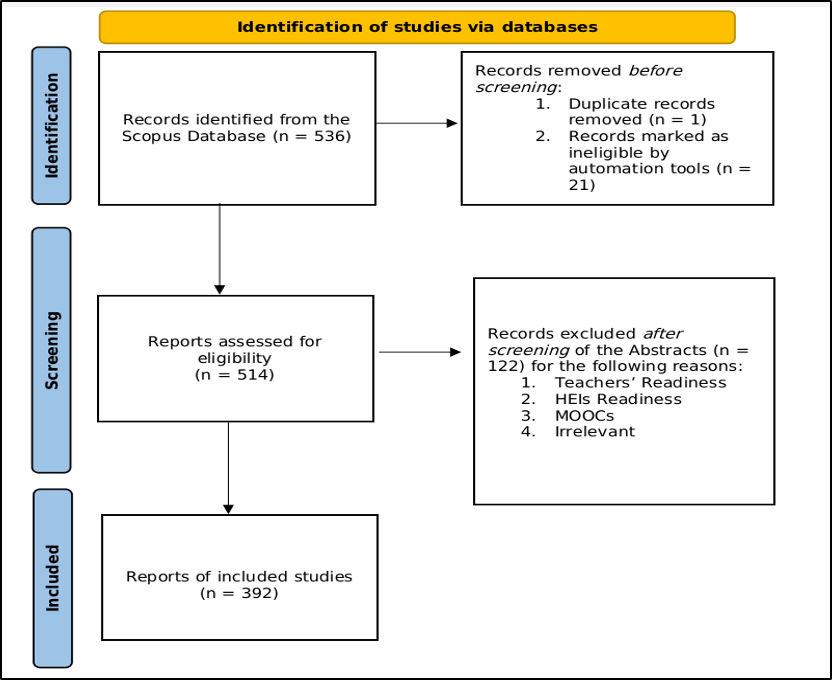
2024 VOL. 11, No. 1
Abstract: This paper reports the findings of a bibliometric analysis using VOSviewer on 392 Scopus database documents published from 2003 to 2022, aiming to understand the global landscape of the e-learning field and to identify the most prominent authors, institutions, countries and reference publications, as well as the research topics that have recently received the most attention in students’ readiness for e-learning in Higher Education Institutions (HEIs). The findings indicate that there has been an upward trend in e-learning readiness among students in HEIs over time. Among the countries studied, the United States, Taiwan, Australia, and Malaysia were found to have the most effective approaches to addressing students' readiness for e-learning. The most highly cited author in this field is M-L. Hung. Based on the citations, the most recognised journal in this field was Computers and Education and the universities that were most persuasive were two Taiwan universities in the first position. The data also revealed relatively low levels of collaboration among authors, institutions and nations regarding students' readiness for e-learning.
Keywords: e-learning, students, HEIs, readiness, bibliometric analysis, VOSviewer
The increasing utilisation of Information and Communication Technology (ICT) has brought about a noteworthy transformation in the realm of education, resulting in the creation of advanced and innovative learning environments known globally as Smart Learning Environments (SLEs) (Alajmi, Al-Sharafi & Abuali, 2020). E-learning enhances the learning experience by providing easy access to resources and facilitating remote collaboration. However, it does not confirm student attendance like traditional classes do, making it challenging to measure student engagement (Abuhassna et al., 2020). However, the success of e-learning depends on the readiness of students to adapt to this mode of instruction. E-Learning readiness refers to the extent to which an institution and its students are prepared to implement e-Learning. This includes both psychological and technical readiness. Psychological readiness refers to the students' motivation and self-regulation skills, while technical readiness refers to the students' ability to use computers and other e-Learning technologies (Borotis & Poulymenakou, 2004). The readiness of students for e-learning encompasses various factors such as their technical skills, self-directed learning abilities, motivational (Alajmi, Al-Sharafi, & Abuali, 2020) technical, social, informational, and epistemological digital competencies (Blayone, Mykhailenko, vanOostveen et al., 2018) perceived usefulness, perceived self-efficacy, perceived ease of use and the behavioural intention of students (Khan et al., 2021).
There are number of empirical studies (Blayone et al., 2018; Blayone et al., 2018; Borotis & Poulymenakou, 2004; Chaka & Govender, 2017; Chung et al., 2020; Coopasami et al., 2017; Hung et al., 2010) on the specified topic of the Scopus database but, to the best of the author's knowledge, a comprehensive review on students' readiness for e-learning in Higher Education Institutions (HEIs) utilising bibliometric analysis in the Scopus database has not been conducted. This study represents the effort to conduct a quantitative analysis of the literature in this domain through bibliometric analysis using Scopus. The primary objective of this study was to enrich understanding of students' readiness for e-learning in HEIs and predicting forthcoming trends through the application of VOSviewer (van Eck & Waltman, 2014).
Several studies have been conducted to investigate the readiness of students for e-learning (Rafique et al., 2021). One such study was the research paper by Hung et al. (2010), which aimed to develop a scale to measure the readiness of students for e-learning and to explore the perceptions of students regarding their readiness. Coopasami et al. (2017) conducted a study to assess students' readiness to make the shift from traditional learning to the technological culture of e-Learning at a university in Durban. The results showed that while students' psychological readiness for e-Learning was high, they lacked technological and equipment readiness. These technical aspects require attention before e-Learning can be implemented effectively in this institution. However, these technical aspects are easier to resolve than improving psychological readiness.
The Covid-19 pandemic led to widespread closure of educational institutions, disrupting traditional learning (Loglo & Zawacki-Richter, 2023). Online learning emerged as a viable alternative, offering continued education opportunities and, potentially, broadening access (Biccard et al., 2023). However, it also unveiled challenges, notably digital disparities. Issues ranged from mental accessibility concerns, like anxiety, to material access obstacles, such as device and internet availability (Biccard et al., 2023). Competency access, involving technology proficiency and usage access problems were also identified (Dhawan, 2020). Experts recommended student and teacher training and investment in technology infrastructure as solutions (Dangol & Shrestha, 2019). Digital competence was highlighted as crucial for e-learning success (Zhao et al., 2021). Nonetheless, there's a lack of consensus on its definition and assessment (Zhao et al., 2021). Higher education institutions are urged to focus on developing digital skills among students (Blayone et al., 2018; Khan, 2021)
This research adds significant value to the existing body of literature in several ways. Firstly, it stands as the initial examination of students' readiness for e-learning in Higher Education Institutions (HEIs) utilising a bibliometric methodology, ensuring comprehensive coverage across various scientific databases. Secondly, the study offers a systematic overview of recent scholarly contributions by employing bibliographic coupling and analysing citation patterns. Moreover, it highlights potential avenues for future research within the field. In summary, this research represents a pioneering endeavor in mapping the landscape of research on students' readiness for e-learning in HEIs using bibliometric techniques, emphasising current insights and prospective research directions. The findings of this study serve as a valuable resource for educators, policymakers and researchers to collaboratively improve and adapt online education in light of the evolving educational landscape.
In order to stay abreast of current trends, researchers need to be knowledgeable about prominent journals in their field, influential articles, leading scholars and the evolution of their discipline. A thorough comprehension of the subject necessitates a thematic review of the pertinent literature (Ansari et al., 2022). Utilising bibliometric analysis, this study scrutinised scholarly publications spanning 2003 to 2022 and covering almost two decades. Specifically, the current review study addressed the following research questions:
RQ1. What is the annual publication trend in the field?
RQ2. Who are this field's leading participants (authors, institutions and countries)?
RQ3. Which are the leading publications (journals and articles)?
RQ4. What is the intellectual structure of this field (keywords and bibliographic coupling)?
RQ5. What potential future research directions could enhance the current literature?
Performing an extensive literature review is essential for advancing research across all disciplines, as it lays the groundwork for understanding existing knowledge (Verma & Malhotra, 2023; Zupic & Čater, 2015). While narrative reviews may exhibit bias, the utilisation of bibliometric analysis ensures a quantitative and impartial approach to literature review (Zupic & Čater, 2015). Bibliometric analysis enhances transparency and reproducibility in the review process by systematically extracting and analysing a large volume of scholarly articles. Moreover, this method facilitates the identification of current trends and potential research areas (Batra et al., 2023; Joshipura & Wats, 2023; Tian & Huber, 2020), serving as a valuable resource for researchers seeking to objectively understand the most influential contributions (Bajaj et al., 2022; Zupic & Čater, 2015).
The bibliographic database Scopus was employed for our study's coverage. To find and filter publications, we used the PRISMA (Primary Reporting Items for Systematic Reviews and Meta-Analysis; Liberati et al., 2009) protocol (see Figure 1). On September 9, 2022, Scopus was consulted and 536 publications in total were found. The following search term was used in the database covering 2003 to 2022 Collection of Scopus to extract a sample set of pertinent literature: TITLE-ABS-KEY ("e-learning" OR "online learning" OR "Digital learning" OR "Internet based learning" OR "Online Education" AND "HEIs" OR "University" OR "College" AND "Readiness" AND "Student*" OR "Learner*") AND (LIMIT-TO (PUBSTAGE, "final") AND ( LIMIT-TO ( LANGUAGE, "English").


The number of HEI papers on students' readiness for e-learning published between 2003 to 2022 is depicted in Figure 2. Data indicate that from 1 (2003) to 58 (2022) papers, HEI research on students' preparation for e-learning has greatly increased. There was just one article published in 2003, followed by 11 in 2010, 57 in 2020, and 98 in 2021. We noted that there were more articles published in 2019, 2020 and 2021, which was one of the ways to guarantee learning continuity throughout Covid-19.

The top 10 countries by the number of documents published have been shown in Figure 3, consisting of Malaysia (42), Indonesia and the USA (38), the Russian Federation (30), Iran, India and Taiwan (13).
We investigated the level of cooperation between authors who published research on students' readiness for e-learning in higher education institutions (HEIs). The study began with a list of 1145 authors who had published at least two papers on this topic and at least two of their papers had been cited at least twice. This initial list was then reduced to 50 authors who met these criteria. The study then used a network analysis approach to identify the different groups of authors who had collaborated on research on this topic. The analysis found that there were 26 separate groups of authors (see Figure 4), but only one of these groups was found to be closely related (see Figure 5). This group consisted of a few researchers who collaborated on several papers together.
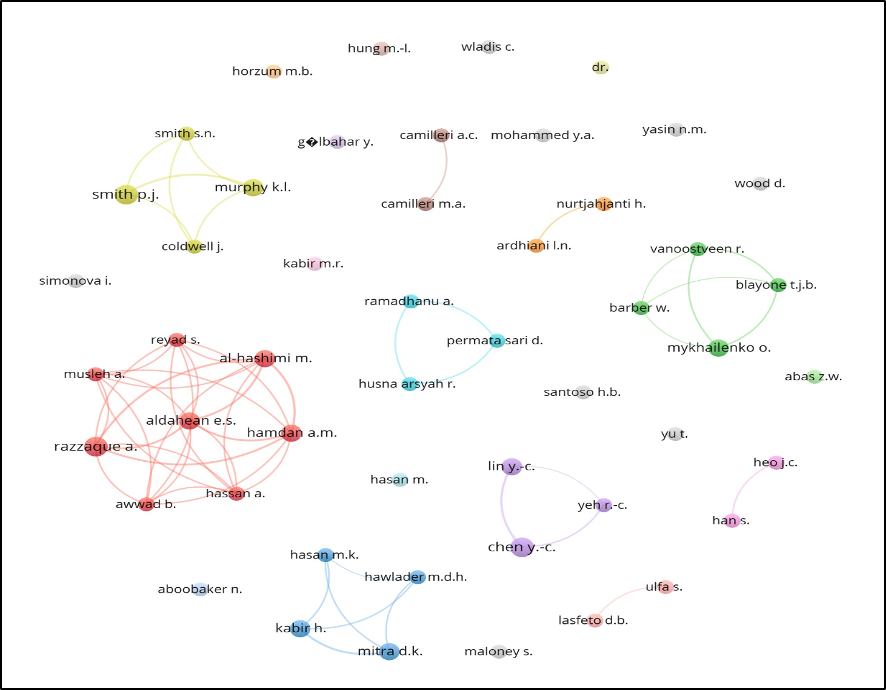
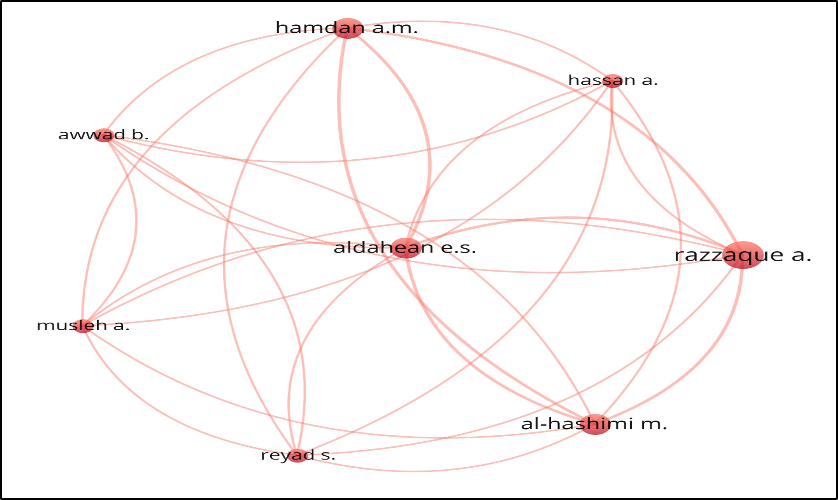
Identifying researcher cooperation on a national basis in students' readiness for e-learning in HEIs takes into consideration nations with at least five publications and at least five citations. According to our research, only 26 nations out of 84 matched this condition but only 19 of them were linked and formed various co-author groups. Figure 6 depicts the nations where authors collaborate. Malaysia and Saudi Arabia are the most persuasive nations in terms of collaboration, as per total link strength (TLS) value. Surprisingly, five clusters formed:
Cluster 1 (Red): Australia, China, Germany, Indonesia, South Korea and the USA
Cluster 2 (Green): India, Jordan, Philippines, Taiwan and Thailand
Cluster 3 (Blue): Bahrain, Pakistan and Saudi Arabia
Cluster 4 (Yellow): Bangladesh, Iran and Malaysia
Cluster 5 (Purple): Egypt and the United Kingdom

Most Persuasive Authors
According to the citation study, which included authors with at least two publications and two citations, just 50 researchers out of 1145 satisfied the criterion, and only 28 were related. Table 1 lists the top ten authors with the highest citation value. M-L. Hung is clearly the most persuasive author. This finding indicates that, despite extensive research, collaboration among researchers is quite poor. With two publications, M-L. Hung is the most persuasive author when the number of citations and TLS are combined, cited 344 times and 42 as TLS value.
Table 1: Most Persuasive Authors Ranked by Citation

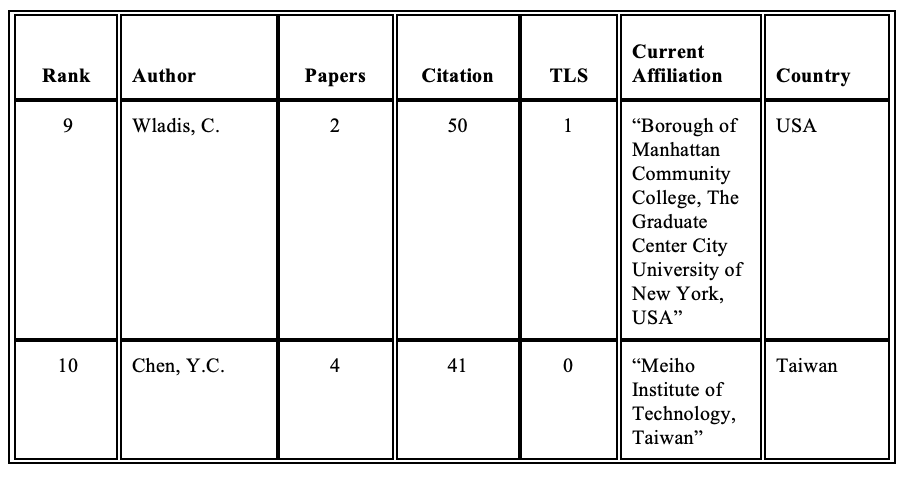
Most Persuasive Publications
From the 392 publications analysed on the basis of a minimum 10 citations on a document, only 90 papers met the criteria and out of which only 36 papers were connected to each other. Table 2 lists the top ten most impactful publications. The most often referenced (344 times) paper on e-learning readiness among students at HEIs was one by Hung et al. titled Learner readiness for online learning: Scale development and student perceptions, published in the journal Computers and Education in 2010. The study highlights the relevance of self-regulation, motivation and technology skills in determining student readiness for online learning. The scale developed in this study can be used to assess student readiness for online learning and to identify areas where students may need support. Smith et al., who published the papers Learning preferences and readiness for online learning in 2005, in the journal Educational Psychology (cited 74 times) and Towards identifying factors underlying readiness for online learning: An exploratory study, stood at the second and fifth position among the top 10 authors in the journal International Journal of Phytoremediation in 2003. The exploratory study identified several key factors that contributed to student readiness, including self-regulation, motivation, and technology skills. Both studies provide important insights into the factors that contribute to student success in online learning environments. The findings of these studies can be used to inform the development of support and resources for students who are transitioning to online learning. However, there are two Hot Papers, one by Chung et al. (2020), cited 123 times, and ranked third, Online learning readiness among university students in Malaysia amidst Covid-19, and the other by Khan et al., (2021), ranked seventh, Students' perception towards e-learning during Covid-19 pandemic in India: An empirical study, cited 59 times, and ranked eighth.
Table 2: Most Persuasive Publications
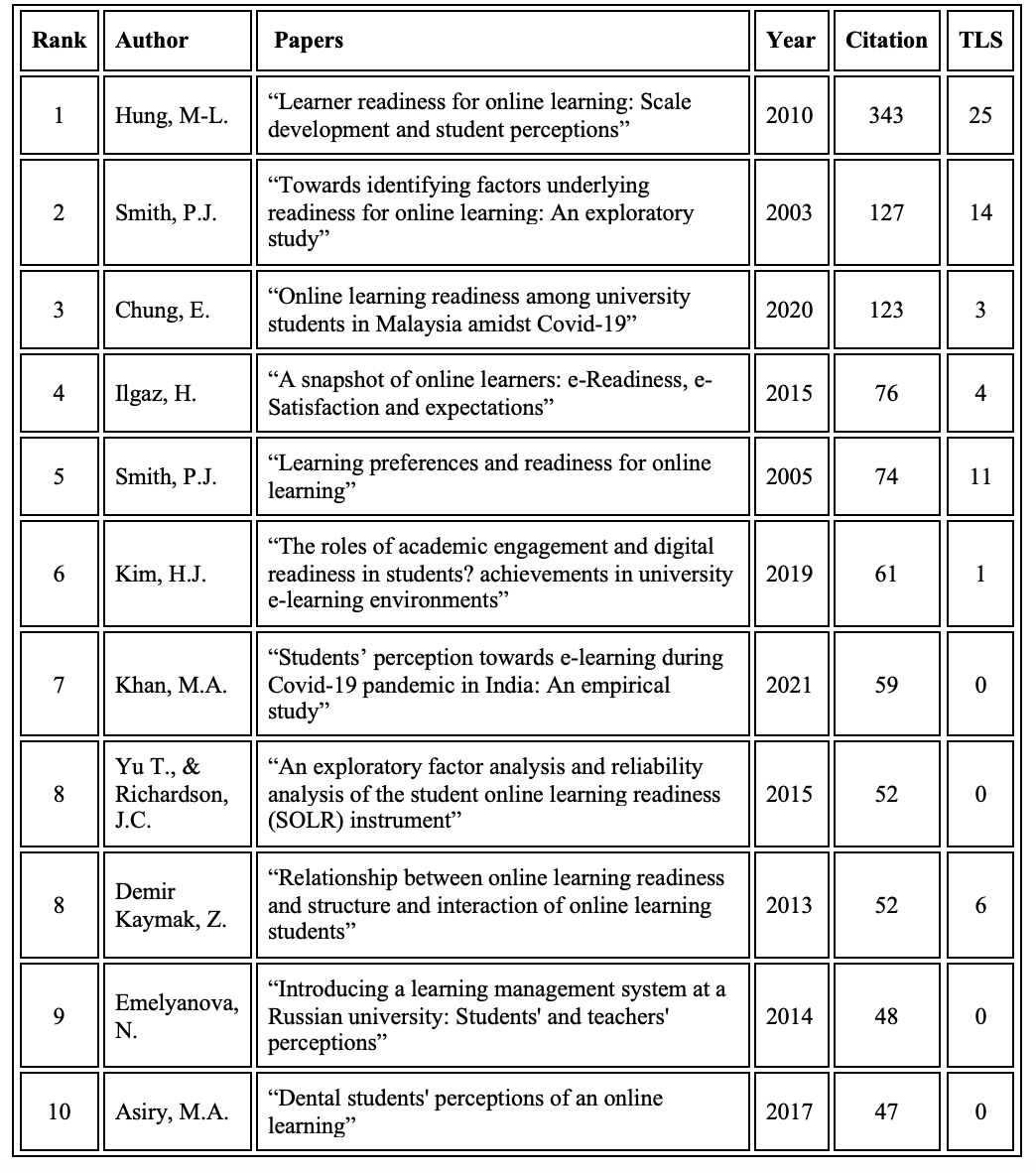
Most Persuasive Journals
A bibliometric study was performed to identify the leading publication that conducted research on student preparedness for e-learning in higher education institutions. Out of 278 journals/publishers, only 47 produced at least 10 articles on the subject between 2003 and 2022. Only 31 of the 47 journals were related to each other. The results are summarised in Table 3, which shows the top ten journals with the highest number of citations. The journal with the most citations was Computers and Education, which published three articles and got 379 citations.
Table 3: Most Persuasive Journals
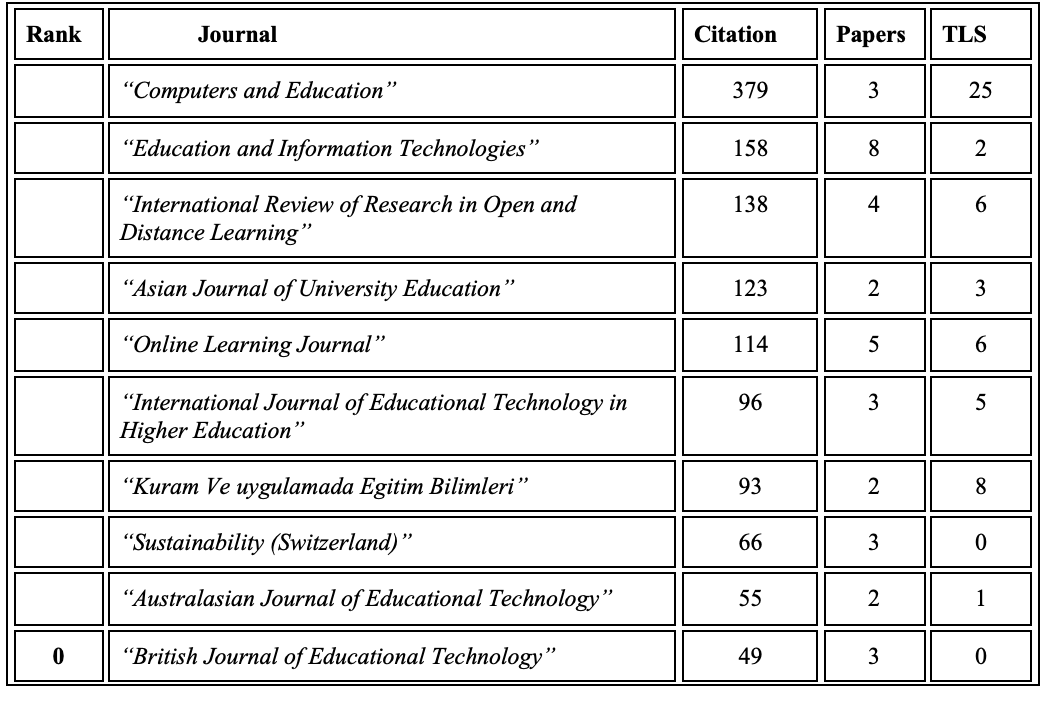
Most Persuasive Countries
A citation analysis was carried out taking into account the quantity of citations in order to determine the most significant nation in the research on students' readiness for e-learning. Only 26 of the 84 nations have published at least five papers, received at least five citations, and are related to at least 24 other nations. Table 4 lists the top 10 nations with the greatest number of citations that are most prepared for e-learning.
Table 4: Most Persuasive Countries on Students’ Readiness for e-Learning in HEIs
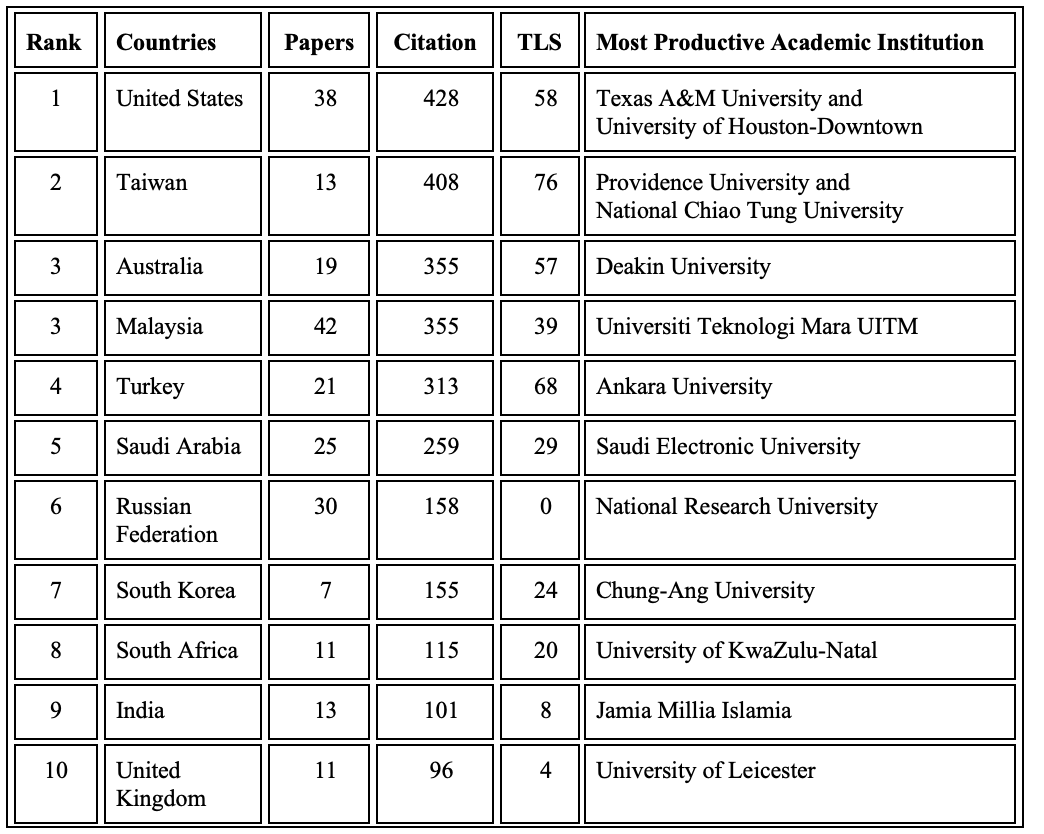
Most Persuasive Universities
Citation analysis was done on the 770 universities to determine which one had the most influence when it came to preparing students for e-learning. Since there weren’t many papers in this subject overall, institutions with at least one published document were taken into account. However, to preserve the quality of the research, institutions also had to be mentioned at least ten times. Table 5 lists the top ten important colleges with the most citations. Two Taiwanese universities, Providence University and National Chiao Tung University, took the top spot. There was minimal university-to-university cooperation.
Table 5: Most Persuasive Universities on Students’ Readiness for e-Learning in HEIs
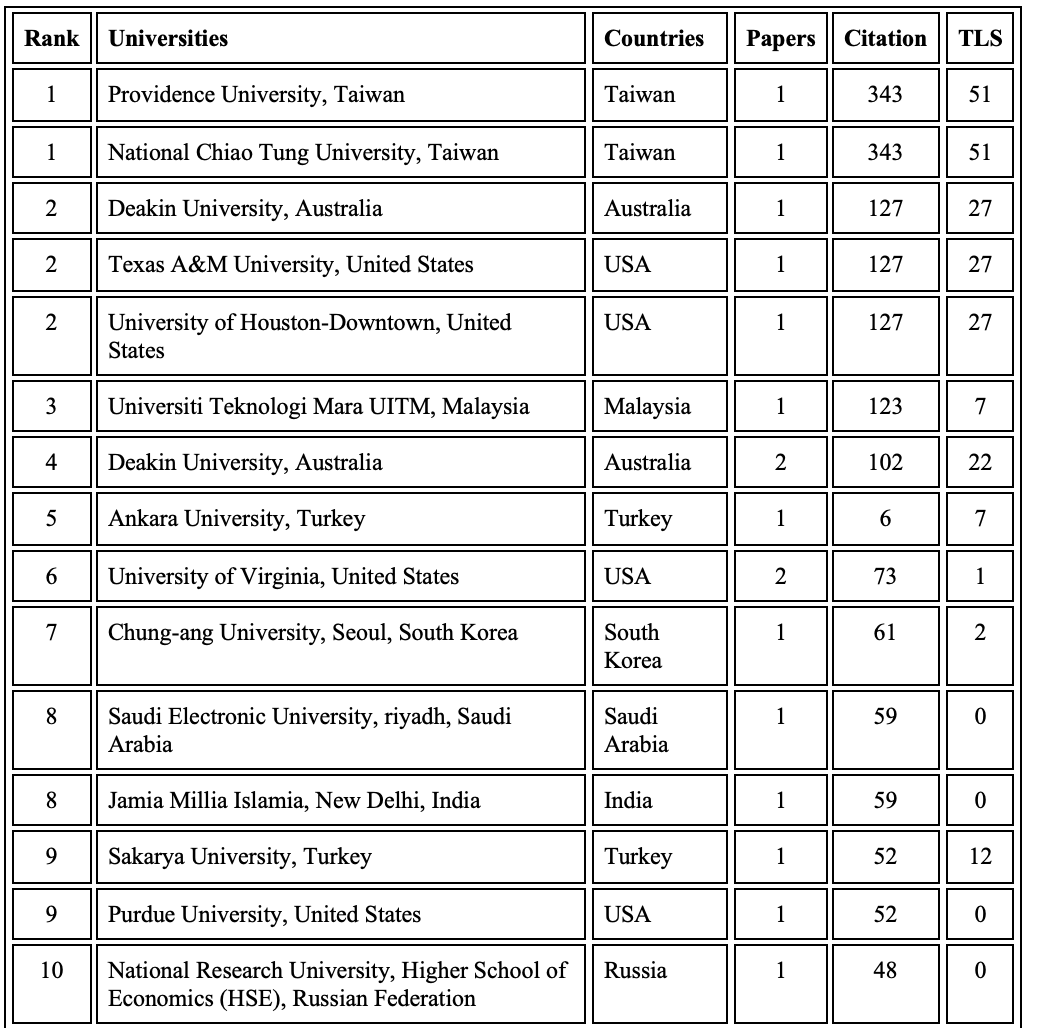
Keywords Analysis and e‑Learning Trend Topics
An analysis of 392 research papers on students' preparedness for e-learning at universities revealed a total of 2015 keywords. The co-occurrence examination showed that only 119 keywords appeared frequently, with a minimum frequency of five. Table 6 presents the top 10 keywords that appeared frequently in the analysed articles.
Table 6: Top 10 Most Frequently Appeared Keywords
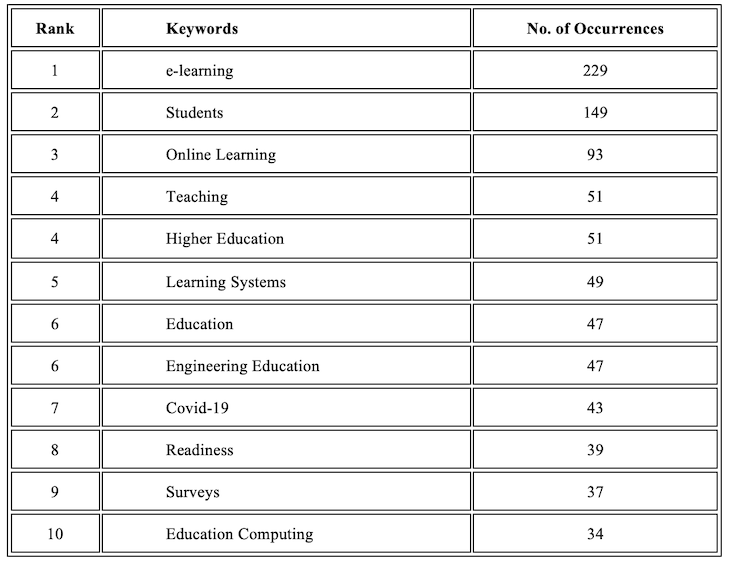
The keyword co-occurrence analysis results are visualised in Figure 7, showing the trends in research subjects from 2016 to 2021 (Ozturk & Ayaz-Alkaya, 2021). Figure 7 can be divided into three clusters, which is presented in Table 7.
Table 7: Clusters Formed Based on Keywords
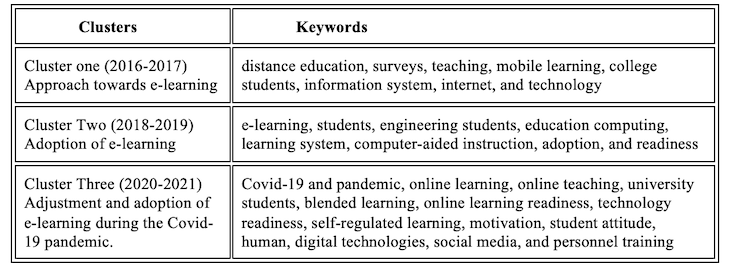

Notably, in recent years (2020-2021), terms like Covid-19 and pandemic have become prominent (Cluster Three of Table 7). This reflects researchers' increased interest in Covid-19's influence on e-learning. This is, in fact, supported by the studies of Chung and Mathew (2020); Khan et al. (2021); Rafique et al. (2021); Nassr et al.(2020); Goel et al. (2022), and the other 140 out of 392 published publications included in this analysis that considers how Covid-19 has affected the learners' lives.
Cluster Analysis
Bibliographic coupling of documents (see Figure 8) is employed to fetch out the clusters so that a clear picture of research themes can be identified and future directions sought out (Donthu et al., 2021).
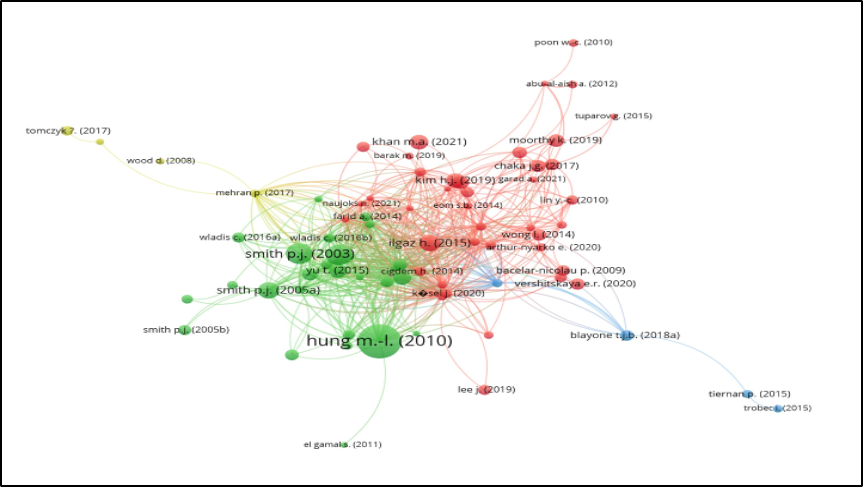
Cluster 1 (Red): Perception and Challenges
The literature review presents valuable insights into different facets of blended learning, e-learning, mobile learning, and digital education readiness. Wong et al. (2014) emphasise strong support for face-to-face delivery methods. Emelyanova and Voronina (2014) reveal that both teachers and students perceive the Learning Management System (LMS) as user-friendly, but also teachers consider it time-consuming. Ilgaz and Gülbahar (2015) identify accessibility and individual responsibilities as influential factors in choosing e-learning, while technical issues and
evaluation impact dissatisfaction. Shorfuzzaman and Alhussein (2016) demonstrated that higher education learners are prepared to embrace mobile learning, with performance expectancy and effort expectancy playing significant roles. Chaka and Govender (2017) highlighted positive perceptions of mobile learning among Nigerian college students. Abdullah and Toycan (2018) and Küsel et al. (2020) identified barriers to e-learning implementation in developing countries, encompassing technology infrastructure, human resources, educational content, administrative policies and cultural factors. Leontyeva (2018) raised concerns about interaction quality and technological infrastructure in online learning. Moorthy et al. (2019) underscored the impact of habits on accounting students' intention to adopt mobile learning. Nassr et al. (2020) uncovered variations in readiness based on physical, environmental, and psychological factors. Küsel et al. (2020) revealed disparities in confidence levels between German and US students, potentially due to cultural dissimilarities. Arthur-Nyarko et al. (2020) highlighted students' preparedness to employ digital learning materials, particularly through personal smartphones. Khan et al. (2021) affirmed students' positive perception and acceptance of e-learning in India. Rafiee & Abbasian-Naghneh (2021) concluded that perceived enjoyment did not significantly influence e-learning acceptance and readiness among language learners. These findings provide valuable insights into the effectiveness, acceptance and readiness of diverse digital education approaches, offering implications for educational institutions and policymakers.
Cluster 2 (Green): Scale Development and Validation
In conclusion, multiple studies provide valuable insights into factors associated with readiness for online learning and the effectiveness of related surveys. The McVay Readiness for Online Learning questionnaire demonstrates consistent factor structure and reliability, indicating its potential for assessing student dispositions and preferences in online learning (Smith et al., 2003). The Online Learning Readiness Scale (OLRS) captures various dimensions of attitudes and behaviours, emphasising the importance of learner readiness in online education (Hung et al., 2010). Tinto's model identifies internal factors like academic and social integration, goal commitment, institutional commitment and learning community as predictors of student retention (Yu & Richardson, 2015). The SOLR model emphasises social, communication, and technical competencies as vital for measuring student readiness in online learning (Yu, 2018). However, further validation and refinement of these surveys are crucial to ensure their predictive validity in identifying at-risk students in the online environment (Wladis & Samuels, 2016). Future research should explore the factors influencing online student outcomes and college progression to support evidence-based decision-making (Wladis & Samuels, 2016). The SOLR instrument provides a reliable measure of students' competencies in online learning, benefiting researchers and practitioners in higher education (Yu, 2018). Gender, degree level and access to technology contribute to variations in student readiness and satisfaction with online learning experiences (Chung et al., 2020). Motivation and academic stress are significant predictors of self-directed learning readiness, while age has limited influence among online college students (Heo & Han, 2018). Furthermore, disparities in self-efficacy and readiness dimensions are observed among LIS students based on gender, degree level, age and grades (Rafique et al., 2021). These findings underscore the complexity of online learning readiness and the ongoing need for research and refinement of assessment measures.
Cluster 3 (Blue): Digital Competencies
This literature review examined the digital competencies of university students and professors for online learning, as well as the use of digital technologies in higher education teaching. Blayone, Mykhailenko, van Oostveen et al. (2018) surveyed the digital competencies of university students and professors in Ukraine for fully online collaborative learning, finding that while students possess some digital skills, they lacked the necessary competencies to fully engage in online collaborative learning. Blayone, Mykhailenko, Kavtaradze et al. (2018) further profiled the digital readiness of higher education students for transformative online learning in the post-Soviet nations of Georgia and Ukraine, highlighting the need for institutions to consider learners' technological, social, and cultural backgrounds when designing online learning environments. Trobec & Starcic (2015) explored the development of nursing ethical competencies online versus the traditional classroom, finding that students' digital competencies are important for effective online learning and ethical competence development. Tiernan (2015) investigated the current and future uses of digital video in university teaching, emphasising the need for educators to understand digital literacy and to align digital technologies with pedagogical goals. These studies highlight the importance of digital competencies for successful online learning and teaching, and suggest the need for educators to consider learners' backgrounds and pedagogical goals when designing digital learning environments.
Cluster 4 (Yellow): Digital Readiness
This literature review examines the readiness of learners for digital learning environments, focusing on the challenges and opportunities presented by 3D virtual environments, e-learning, and the use of new media in teacher training. Wood & Hopkins (2008) found that while businesses are ready for 3D virtual learning, students may not have been adequately prepared for the changes it brought. Raturi et al. (2011) emphasised that while Pacific Island learners had access to technology, they lacked the necessary skills and experience to effectively utilise it for learning. Mehran et al. (2017) concluded that Japanese digital natives had high levels of access to technology but lacked the digital literacy skills necessary for effective e-learning. Finally, Tomczyk et al. (2017) suggested that the frequency and quality of using ICT in the didactic process and gaining experience determined teachers' readiness to implement innovative methodological solutions. To improve student engagement and outcomes, it is important to address issues such as server stability problems, complex interfaces, inappropriate commercial platforms, upload costs and security concerns associated with 3D virtual learning environments (Wood & Hopkins, 2008). Additionally, fostering a better understanding of the value of e-learning and the need for digital literacy skills could improve learners' ability to effectively utilise technology for learning (Raturi et al., 2011).
A summary of all clusters and future agendas is shown in Table 8.
Table 8: Future Agendas on Students’ Readiness for e-learning in HEIs
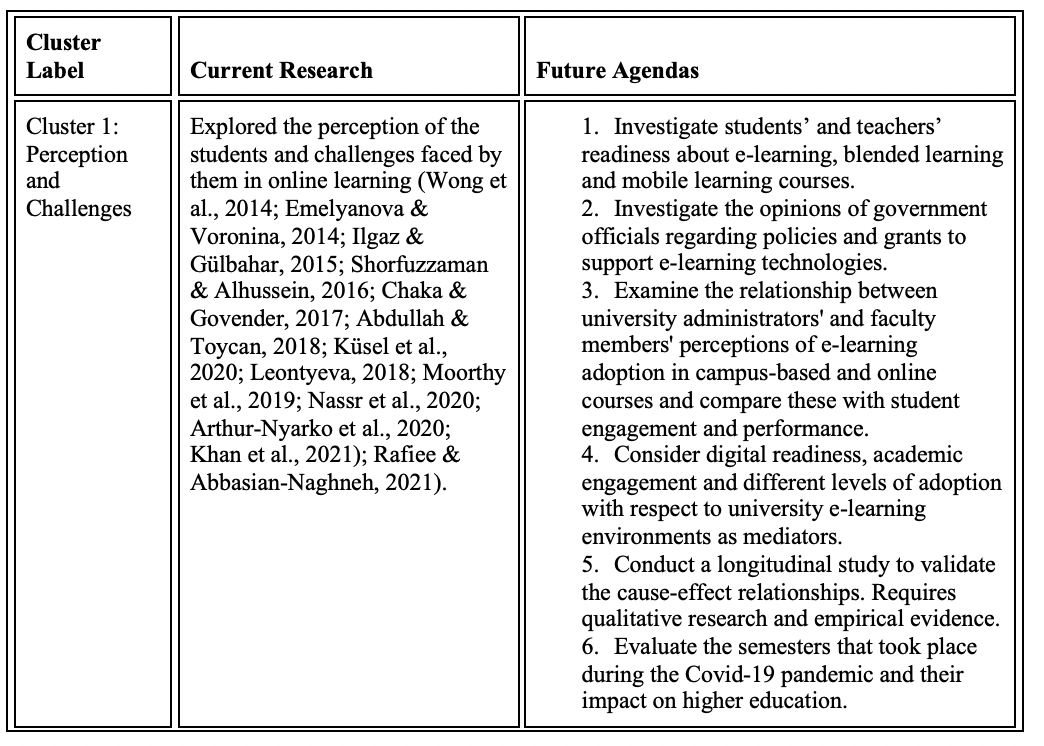
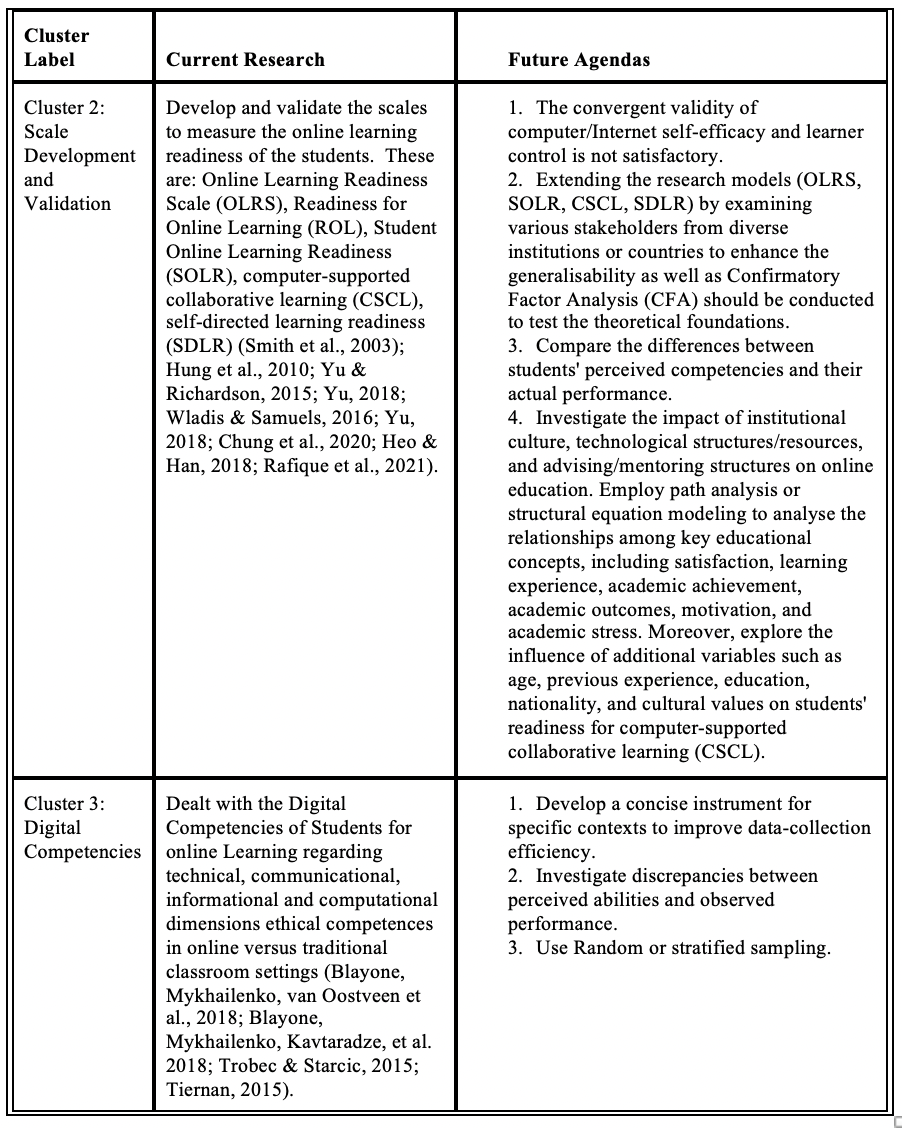
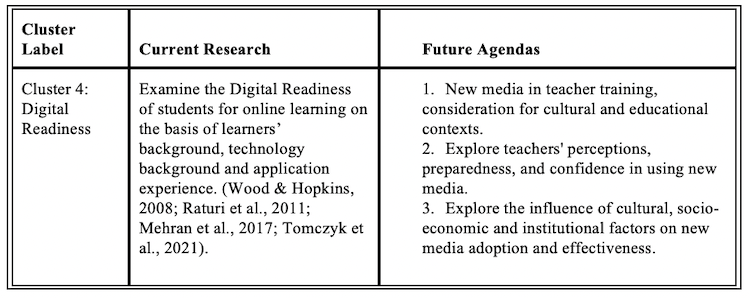
This bibliometric analysis review examined 392 research papers retrieved from the Scopus database to provide an overview of students' readiness for online learning in higher education institutions (HEIs). The analysis revealed an increasing interest in studying e-learning readiness among students. Malaysia had the highest number of published documents, while the USA received the highest number of citations (428). Providence University and National Chiao Tung University of Taiwan ranked first in qualitative work. The most cited journal was Computers and Education (379 citations), with the most cited paper being Learner readiness for online learning: scale development and student perceptions by prolific author M-L. Hung, Co-authorship analysis showed limited connections among authors and collaboration among countries.
The study has limitations, including the use of only Scopus data, exclusion of recently accepted but unpublished papers, and consideration of only English-language publications. However, these limitations are unlikely to significantly impact the study's results. It is important to note that this research focuses solely on students' readiness for e-learning in HEIs within the broader field of e-learning.
Abdullah, M.S., & Toycan, M. (2018). Analysis of the factors for the successful e-learning services adoption from education providers’ and students’ perspectives: A case study of private universities in Northern Iraq. Eurasia Journal of Mathematics, Science and Technology Education, 14(3), 1097-1109. https://doi.org/10.12973/ejmste/81554
Abuhassna, H., Al-Rahmi, W.M., Yahya, N., Zakaria, M.A.Z.M., Kosnin, A.B.M., & Darwish, M. (2020). Development of a new model on utilizing online learning platforms to improve students’ academic achievements and satisfaction. International Journal of Educational Technology in Higher Education, 17(1). https://doi.org/10.1186/s41239-020-00216-z
Alajmi, Q., Al-Sharafi, M.A., & Abuali, A. (2020). Smart Learning Gateways for Omani HEIs Towards Educational Technology: Benefits, Challenges and solutions. International Journal of Information Technology and Language Studies (IJITLS).
Ansari, Y., Albarrak, M.S.,Sherfudeen, N., & Aman, A . (2022). A study of financial literacy of investors—A bibliometric analysis. International Journal of Financial Studies. MDPI. https://doi.org/10.3390/ijfs10020036
Arthur-Nyarko, E., Agyei, D.D., & Armah, J.K. (2020). Digitizing distance learning materials: Measuring students’ readiness and intended challenges. Education and Information Technologies, 25(4), 2987-3002. https://doi.org/10.1007/s10639-019-10060-y
Biccard, P., Mudau, P.K., & van den Berg, G. (2023). Student perceptions of online examinations as an emergency measure during Covid-19. Journal of Learning for Development, 10(2), 222–235. https://doi.org/10.56059/jl4d.v10i2.672
Bajaj, V., Kumar, P., & Singh, V.K. (2022). Linkage dynamics of sovereign credit risk and financial markets: A bibliometric analysis. Research in International Business and Finance, 59(March 2021), 101566. https://doi.org/10.1016/j.ribaf.2021.101566
Batra, S., Saini, M., Yadav, M., & Aggarwal, V. (2023). Mapping the intellectual structure and demystifying the research trend of cross listing: a bibliometric analysis. Managerial Finance, 49(6), 992-1016. https://doi.org/10.1108/MF-07-2022-0330
Blayone, T.J.B., Mykhailenko, O., Kavtaradze, M., Kokhan, M., van Oostveen, R., & Barber, W. (2018). Profiling the digital readiness of higher education students for transformative online learning in the post-soviet nations of Georgia and Ukraine. International Journal of Educational Technology in Higher Education, 15(1). https://doi.org/10.1186/s41239-018-0119-9
Blayone, T.J.B., Mykhailenko, O., van Oostveen, R., Grebeshkov, O., Hrebeshkova, O., & Vostryakov, O. (2018). Surveying digital competencies of university students and professors in Ukraine for fully online collaborative learning. Technology, Pedagogy and Education, 27(3), 279-296. https://doi.org/10.1080/1475939X.2017.1391871
Borotis, S., & Poulymenakou, A. (2004). E-Learning Readiness Components: Key Issues to Consider Before Adopting e-Learning Interventions. Proceedings of E-Learn 2004—World Conference on E-Learning in Corporate, Government, Healthcare, and Higher Education, 2004(1).
Chaka, J. G., & Govender, I. (2017). Students’ perceptions and readiness towards mobile learning in colleges of education: A Nigerian perspective. South African Journal of Education, 37(1), 1-12. https://doi.org/10.15700/saje.v37n1a1282
Chung, E., Subramaniam, G., & Dass, L. C. (2020). Online learning readiness among university students in Malaysia amidst Covid-19. Asian Journal of University Education, 16(2), 45-58. https://doi.org/10.24191/AJUE.V16I2.10294.
Coopasami, M., Knight, S., & Pete, M. (2017). e-Learning readiness amongst nursing students at the Durban University of Technology. Health SA Gesondheid, 22. https://doi.org/10.1016/j.hsag.2017.04.003
Dangol, R., & Shrestha, M. (2019). Learning readiness and educational achievement among school students. The International Journal of Indian Psychology, 7(2).
Dhawan, S. (2020). Online learning: A panacea in the time of COVID-19 crisis. Journal of Educational Technology Systems, 49(1). https://doi.org/10.1177/0047239520934018.
Donthu, N., Kumar, S., Mukherjee, D., Pandey, N., & Lim, W.M. (2021). How to conduct a bibliometric analysis: An overview and guidelines. Journal of Business Research, April, 133, 285-296. https://doi.org/10.1016/j.jbusres.2021.04.070
Emelyanova, N., & Voronina, E. (2014). Introducing a learning management system at a Russian university: Students’ and teachers’ perceptions. International Review of Research in Open and Distance Learning, 15(1), 272-289. https://doi.org/10.19173/irrodl.v15i1.1701
Goel, P., Garg, A., Walia, N., Kaur, R., Jain, M., & Singh, S. (2022). Contagious diseases and tourism: A systematic review based on bibliometric and content analysis methods. Quality and Quantity, 56(5). https://doi.org/10.1007/s11135-021-01270-z
Heo, J.C., & Han, S. (2018). Effects of motivation, academic stress and age in predicting self-directed learning readiness (SDLR): Focused on online college students. Education and Information Technologies, 23(1), 61-71. https://doi.org/10.1007/s10639-017-9585-2
Hung, M-L., Chou, C., Chen, C.H., & Own, Z.Y. (2010). Learner readiness for online learning: Scale development and student perceptions. Computers and Education, 55(3), 1080-1090. https://doi.org/10.1016/j.compedu.2010.05.004
Ilgaz, H., & Gülbahar, Y. (2015). A snapshot of online learners: e-Readiness, e-Satisfaction and expectations. International Review of Research in Open and Distance Learning, 16(2), 171-187. https://doi.org/10.19173/irrodl.v16i2.2117
Joshipura, M., & Wats, S. (2023). Decoding momentum returns: An integrated bibliometric and content analysis approach. Qualitative Research in Financial Markets, 15(2), 254-277. https://doi.org/10.1108/QRFM-12-2021-0211
Khan, M.A., Vivek, Nabi, M.K., Khojah, M., & Tahir, M. (2021). Students’ perception towards e-learning during Covid-19 pandemic in India: An empirical study. Sustainability (Switzerland), 13(1), 1-14. https://doi.org/10.3390/su13010057
Küsel, J., Martin, F., & Markic, S. (2020). University students’ readiness for using digital media and online learning — Comparison between Germany and the USA. Education Sciences, 10(11), 1-15. https://doi.org/10.3390/educsci10110313
Leontyeva, I.A. (2018). Modern distance learning technologies in higher education: Introduction problems. Eurasia Journal of Mathematics, Science and Technology Education, 14(10), 1-8. https://doi.org/10.29333/ejmste/92284
Liberati, A., Altman, D.G., Tetzlaff, G., Mulrow, C., Gøtzsche, P.C., Ioannidis, J.P.A., Clarke, M., Devereaux, P.J., Kleijnen, J., & Moher, D. (2009). The PRISMA statement for reporting systematic reviews and meta-analyses of studies that evaluate health care interventions: Explanation and elaboration. PLoS Medicine. https://doi.org/10.1371/journal.pmed.1000100.
Loglo, F.S., & Zawacki-Richter, O. (2023). Learning with digital media: A systematic review of students’ use in African higher education. Journal of Learning for Development, 10(1), 1-23. https://doi.org/10.56059/jl4d.v10i1.857
Mehran, P., Alizadeh, M., Koguchi, I., & Takemura, H. (2017). Are Japanese digital natives ready for learning english online? A preliminary case study at Osaka University. International Journal of Educational Technology in Higher Education, 14(1). https://doi.org/10.1186/s41239-017-0047-0
Moorthy, K., Yee, T.T., T’ing, L.C., & Kumaran, V.V. (2019). Habit and hedonic motivation are the strongest influences in mobile learning behaviours among higher education students in Malaysia. Australasian Journal of Educational Technology, 35(4), 174-191. https://doi.org/10.14742/ajet.4432
Nassr, R.M., Aborujilah, A., Aldossary, D.A., & Aldossary, A.A.A. (2020). Understanding education difficulty during Covid-19 lockdown: Reports on Malaysian university students’ experience. IEEE Access, 8, 186939–186950. https://doi.org/10.1109/ACCESS.2020.3029967
Ozturk, F.O., & Ayaz-Alkaya, S. (2021). Internet addiction and psychosocial problems among adolescents during the COVID-19 pandemic: A cross-sectional study. Archives of Psychiatric Nursing, 35(6). https://doi.org/10.1016/j.apnu.2021.08.007.
Rafiee, M., & Abbasian-Naghneh, S. (2021). E-learning: Development of a model to assess the acceptance and readiness of technology among language learners. Computer Assisted Language Learning, 34(5-6), 730-750. https://doi.org/10.1080/09588221.2019.1640255
Rafique, G.M., Mahmood, K., Warraich, N.F., & Rehman, S.U. (2021). Readiness for online learning during Covid-19 pandemic: A survey of Pakistani LIS students. Journal of Academic Librarianship, 47(3), 102346. https://doi.org/10.1016/j.acalib.2021.102346
Raturi, S., Hogan, R., & Thaman, K.H. (2011). Learners’ access to tools and experience with technology at the University of the South Pacific: Readiness for e-learning. Australasian Journal of Educational Technology, 27(3), 411-427. https://doi.org/10.14742/ajet.952
Shorfuzzaman, M., & Alhussein, M. (2016). Modeling learners’ readiness to adopt mobile learning: A perspective from a GCC higher education institution. Mobile Information Systems, 2016. https://doi.org/10.1155/2016/6982824
Smith, P.J., Murphy, K.L., & Mahoney, S.E. (2003). Readiness for online learning: An exploratory study. Distance Education, 24(1), 57-67. https://doi.org/10.1080/0158791032000066525
Tian, M., & Huber, S. G. (2020). Mapping educational leadership, administration and management research 2007-2016: Thematic strands and the changing landscape. Journal of Educational Administration, 58(2), 129-150. https://doi.org/10.1108/JEA-12-2018-0234
Tiernan, P. (2015). An inquiry into the current and future uses of digital video in university teaching. Education and Information Technologies, 20(1), 75-90. https://doi.org/10.1007/s10639-013-9266-8
Tomczyk, Ł., Szotkowski, R., Fabiś, A., Wąsiński, A., Chudý, Š., & Neumeister, P. (2017). Selected aspects of conditions in the use of new media as an important part of the training of teachers in the Czech Republic and Poland — Differences, risks and threats. Education and Information Technologies, 22(3), 747-767. https://doi.org/10.1007/s10639-015-9455-8
Trobec, I., & Starcic, A. I. (2015). Developing nursing ethical competences online versus in the traditional classroom. Nursing Ethics, 22(3), 352-366. https://doi.org/10.1177/0969733014533241.
van Eck, N.J., & Waltman, L. (2014). Visualizing bibliometric networks. In Measuring Scholarly Impact. https://doi.org/10.1007/978-3-319-10377-8_13
Verma, K., & Malhotra, K. (2023). A bibliometric analysis of sport utility vehicle segment in the automobile industry: Two decades study based on web of science database. International Journal of Business and Emerging Markets, 15(2). https://doi.org/10.1504/IJBEM.2023.130476
Wladis, C., & Samuels, J. (2016). Do online readiness surveys do what they claim? Validity, reliability, and subsequent student enrollment decisions. Computers and Education,/ 98, 39-56. https://doi.org/10.1016/j.compedu.2016.03.001.
Wong, L., Tatnall, A., & Burgess, S. (2014). A framework for investigating blended learning effectiveness. Education and Training, 56(2), 233-251. https://doi.org/10.1108/ET-04-2013-0049.
Wood, D., & Hopkins, L. (2008). 3D Virtual environments: Businesses are ready but are our “digital natives” prepared for changing landscapes? ASCILITE 2008 — The Australasian Society for Computers in Learning in Tertiary Education, March, 1136-1146.
Yu, T. (2018). Examining construct validity of the student online learning readiness (SOLR) instrument using confirmatory factor analysis. Online Learning Journal, 22(4), 277-288. https://doi.org/10.24059/olj.v22i4.1297.
Yu, T., & Richardson, J. C. (2015). An exploratory factor analysis and reliability analysis of the student online learning readiness (SOLR) instrument. Online Learning Journal, 19(5). https://doi.org/10.24059/olj.v19i5.593.
Zhao, Y., Pinto Llorente, A.M., & Sánchez Gómez, M.C. (2021) Digital competence in higher education research: A systematic literature review. Computers and Education, 168. https://doi.org/10.1016/j.compedu.2021.104212.
Zupic, I., & Čater, T. (2015). Bibliometric methods in management and organization. Organizational Research Methods, 18(3), 429-472. https://doi.org/10.1177/1094428114562629
Author Notes
https://orcid.org/0009-0000-7642-6321
https://orcid.org/ 0000-0002-0441-5911
Anamica Maan is a research scholar at the Department of Commerce, Maharshi Dayanand University, Rohtak, Haryana, India. She received her MPhil and BEd from MDU Rohtak, and her MCom and MBA from GJUS&T Hisar, Haryana, and successfully cleared CTET, HTET, and UGC NET-JRF in Commerce. She has one year of teaching experience with RPS Group of Institutions Mahendergarh, Haryana. She has presented her research articles at many international/national conferences and has also published research papers in esteemed journals. Email: anamica.rs.comm@mdurohtak.ac.in
Dr. Kapil Malhotra is an Assistant Professor in the Department of Commerce at Maharshi Dayanand University, Rohtak, Haryana, India. He completed his PhD, MCom and MBA at MDU Rohtak and qualified UGC NET-JRF in Management and NET in Commerce. He has presented research articles at numerous international/national conferences and has published many research papers in various journals of high repute. He is a member of University Court and also serves as the Deputy Director of CDS, Departmental Coordinator of the Digital Learning Centre, Program Counsellor of Youth Red Cross and Course Coordinator of the MCom (Online) program at MDU Rohtak. Email: kapil.comm@mdurohtak.ac.in
Cite as: Maan, A., & Malhotra, K. (2024). Mapping students' readiness for e-learning in higher education: A bibliometric analysis. Journal of Learning for Development, 11(1), 27-51.